| Contents Of This Report: |
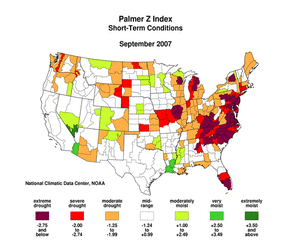 |

|
|
|
|
| During September 2007,
drought expanded in the mid-Atlantic States, decreased in the
northern Great Lakes, and continued to affect a large part of the
western U.S. (U.S. Drought Monitor for end of August vs
end of
September). The month was unusually dry across much of the eastern seaboard, from Maine to the Carolinas, and across parts of Florida. The September dryness extended across the Ohio Valley and into the southern Great Lakes. A drier-than-normal month was also experienced across parts of the Pacific Northwest and northern Plains. Northern stations in Alaska were drier than normal while central and southern stations were wetter than normal. Above-normal rainfall was reported at some Hawaiian stations this month, but most of the islands were dry, continuing a dry pattern which has lasted several months. September was drier than normal across parts of southeastern Puerto Rico, continuing a trend which has lasted much of the year.  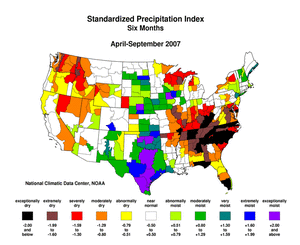 |
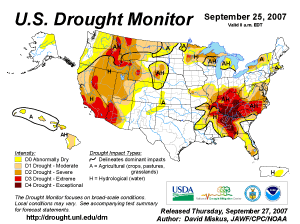 North Carolina and Tennessee had the driest year-to-date (January-September) and last 6 months (April-September) on record. In fact, the 2007 statewide precipitation rank for North Carolina was driest in 113 years for January-September and for the multi-month seasons April-September through August-September. For Tennessee, each multi-month season from November-September through May-September ranked as driest on record. 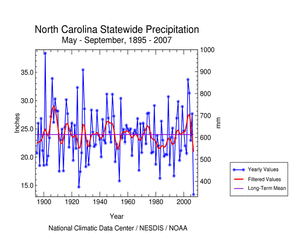 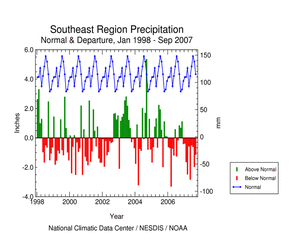 A more detailed drought discussion can be found below. |
|
|
|
For most areas of the Southeast during September, as summarized by the Southeast Regional Climate Center, the continuing drought was a major climatic concern. Three tropical storms affected the region, bringing 6 to 8 inches of rain in some areas. But these amounts were generally rather isolated, localized events -- the prolonged, widespread downpours hoped for by many did not materialize. Nevertheless, almost all areas got some precipitation -- not enough to remove the drought, but sufficient to prevent any records for "longest dry spell" being broken. As a result, drought in September was less severe than in August for northern Virginia, southern (especially southeast) Georgia, and much of Florida outside the panhandle. However, the western and central parts of the region continued to have Exceptional Drought, with some places having an increase in severity. As noted by the Southeast Regional Climate Center, for much of the Southeast, the overall severity of the prolonged drought led to water use restrictions being considered in many municipalities and implemented in some. Some specifics:
As noted by the Northeast Regional Climate Center, with 4 of the previous 5 months yielding below normal precipitation, drought conditions, while not as bad as other areas of the country, expanded in the Northeast. By month's end, the U.S. Drought Monitor had parts of western and northern New York and southwestern West Virginia under Severe Drought conditions. Adjacent to those areas as well as parts of central Connecticut, south central Massachusetts, southern New Jersey, and most of Maryland and Delaware were moderately or abnormally dry. According to the USGS, streamflow was much below normal from eastern Massachusetts to the Washington, DC metro area. Locally, Maryland and Pennsylvania had about half of their counties under a drought watch. In New York, rainfall in the Northern Plateau climate division for August and September was 50% of normal, making the 2-month period the 2nd driest on record. Many areas in upstate New York reported record low reservoir levels and dried up wells and farm ponds. The Canal Corp. diverted water from one reservoir to give relief to another reservoir that is used to power electric plants as well as provide municipal water. Water restrictions were in place in communities throughout the Northeast. On September 14, the USDA made low-interest emergency loans available to farmers affected by drought conditions in Pennsylvania, Maryland and New York. The Small Business Administration announced that small businesses affected by the drought in West Virginia were eligible for federal disaster loans due to drought conditions. As explained by the Midwest Regional Climate Center, precipitation was quite variable across the Midwest during September. Heavy rain that fell over the arrowhead of Minnesota, which had been suffering from Extreme Drought (D3) conditions for much of the summer, helped to nearly wipe out the excessive drought conditions. Overall, drought conditions improved throughout the northern half of the Midwest. All of the states have seen improvement, nearly eliminating the Extreme Drought conditions (as measured by the U.S. Drought Monitor). Conditions across the southern part of the region deteriorated, especially in Kentucky where over half of the state received less than 50% of the rain that typically falls during the month. Heavy rain in the third week of September brought some relief to central Kentucky. Unfortunately, dry weather again took hold and Extreme Drought conditions overtook more than 88% of the state (a 17% increase from the previous week). Drought conditions are also creeping slowly northward into central Illinois, Indiana and Ohio after a slight retreat during the third week of the month. According to an Associated Press report, drought and mild temperatures have pushed Lake Superior's water level to its lowest point on record for this time of year, continuing a downward spiral across the Great Lakes. Preliminary data showed that Superior's average water level in September dipped 1.6 inches beneath the previous low for that month reached in 1926, according to NOAA's Great Lakes Environmental Research Laboratory. The U.S. Army Corps of Engineers, which uses a different measuring technique, calculated the September level at 4 inches below the record. Either way, the lake has plummeted over the past year and has dipped beneath its long-term average level for a decade -- the longest such period in its known history. Some areas had so little water last spring and summer that recreational boats couldn't reach docking slips. Commercial shippers, who haul iron ore and coal across the lakes to manufacturing centers such as Detroit, have been unable to fill cargo holds to capacity for fear of scraping bottom in shallow channels. All the Great Lakes, which together make up about 20 percent of the world's fresh surface water, have been in decline since the late 1990s. Lakes Huron and Michigan were about 2 feet below their long-term average levels, while Lake Superior was about 20 inches off, Lake Ontario 7 inches below, and Lake Erie a few inches down. This year has been very dry in southern California. As of September 25, Pasadena experienced its driest year since records began in 1878, and the mayor has asked Pasadena residents to voluntarily conserve water. In early September, Long Beach imposed the most severe water restrictions seen in the region in years, including forcing residents to cut back on watering their lawns and requiring restaurants to only serve water when customers request it. Mandatory water restrictions were also in place in Sierra Madre. According to media reports, drought conditions have forced the closure of one electricity-generating unit at Palisades Reservoir and are affecting the quality of water coming out of American Falls. Both of these Idaho reservoirs were all but empty by September. Water from Jackson Lake reservoir in northwest Wyoming was being tapped to provide irrigation water to farmers across the Snake River Valley in southern Idaho. During September, the USDA designated several counties in various states as drought disaster areas. These include counties in Minnesota, Pennsylvania, North Carolina, Delaware, and Virginia. |
|
| A detailed review of
drought and moisture conditions is available for all contiguous U.S.
states, the nine standard regions, and
the nation (contiguous U.S.): STATES: REGIONS:
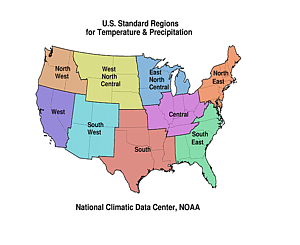
|
|
|
|
 NOAA's National Centers for Environmental Information
NOAA's National Centers for Environmental Information
